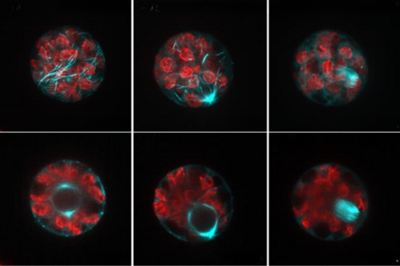The asymmetric journey of the spore nucleus
Multicellular plants and animals are derived from single cells. The diploid phase of animals and plants develops from polarized cells called zygotes. The development of this polarity –different activities at different ends of the cell – programs the subsequent development of the organism ensuring, for example, that the mouth and the anus form on opposite ends.
During their life cycle, plants also develop multicellular haploid phases which originate from spores that develop polarity soon after they start to grow. However, the mechanism by which this polarity is developed in the spore had, so far, remained elusive
Sarah Attrill and Liam Dolan at the Gregor Mendel Institute of Plant Biology (GMI) of the Austrian Academy of Sciences have been investigating how polarity develops in the spore cell of the liverwort Marchantia polymorpha. The first visible expression of polarity is an asymmetric cell division, where the spore divides to form a large apical cell that gives rise to the body of the plant, and a smaller basal rooting cell that will anchor the developing plant in place.
Recently, Attrill and Dolan discovered that nuclear migration accompanies the establishment of cellular asymmetry in the spore of the liverwort Marchantia polymorpha, setting up the fate of the two resulting cells. Their results were published on July 23rd, 2024 in the journal Development.
In the new study, the authors show that nuclear migration during asymmetry establishment is driven by the reorganization of microtubules and actin filaments, structures responsible for the movement of cellular contents. They show that the protein actin, which provides mechanical force in our muscles, pulls the nucleus from the center to the side of the cell during this process. The signals driving this reorganization are, so far, unknown.
The findings by Attrill and Dolan demonstrate that even though plants and animals diverged from each other well over a billion years ago, the mechanisms that establish cellular asymmetry and program the development of multicellularity are remarkably similar in plants and animals.
